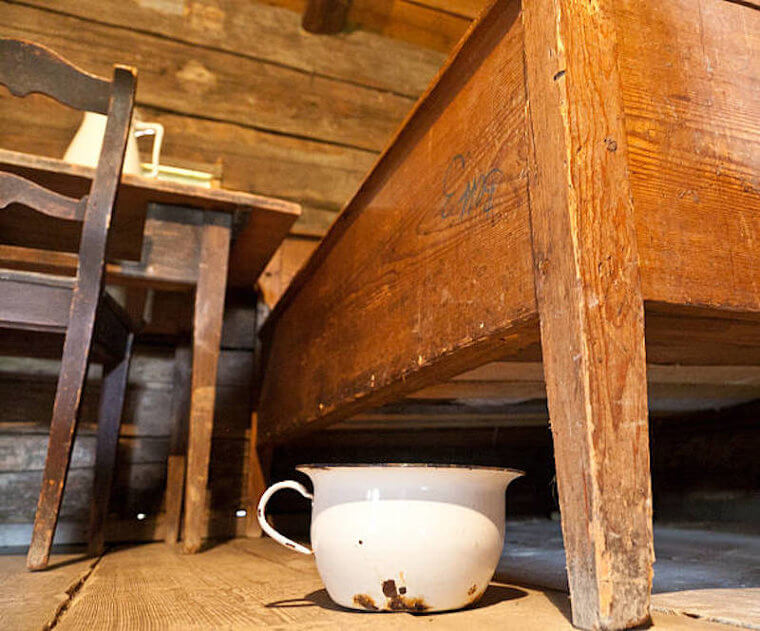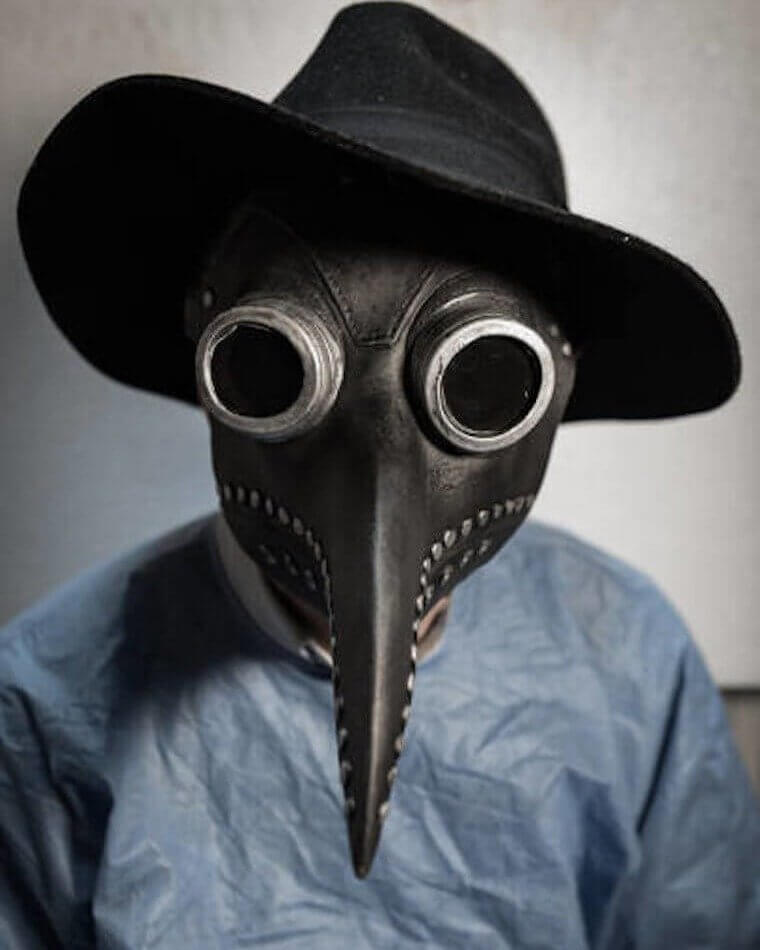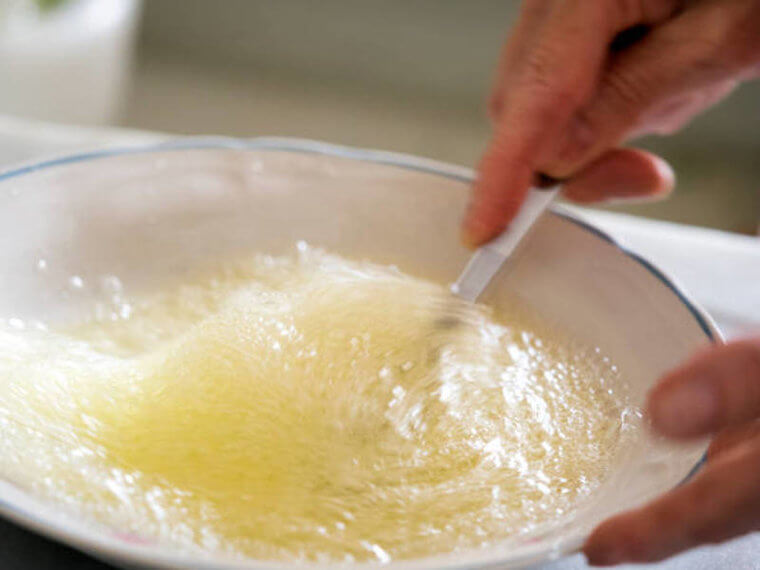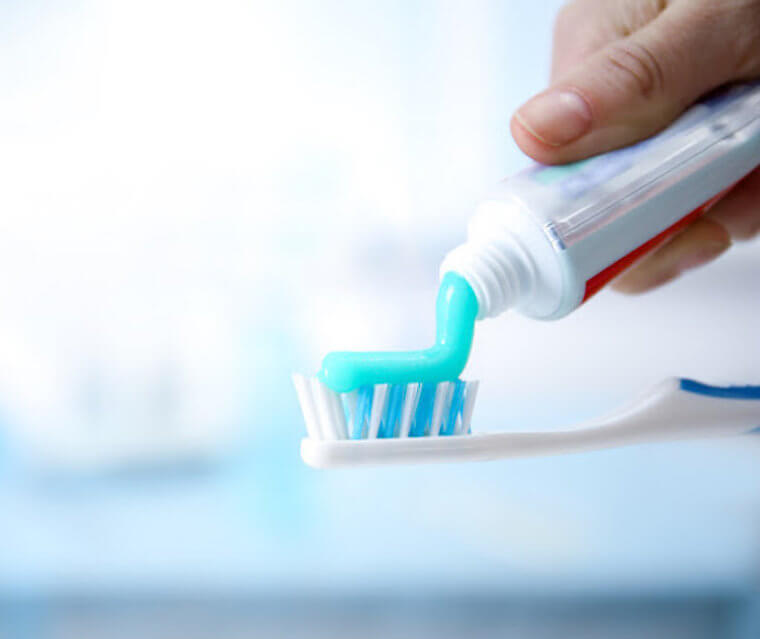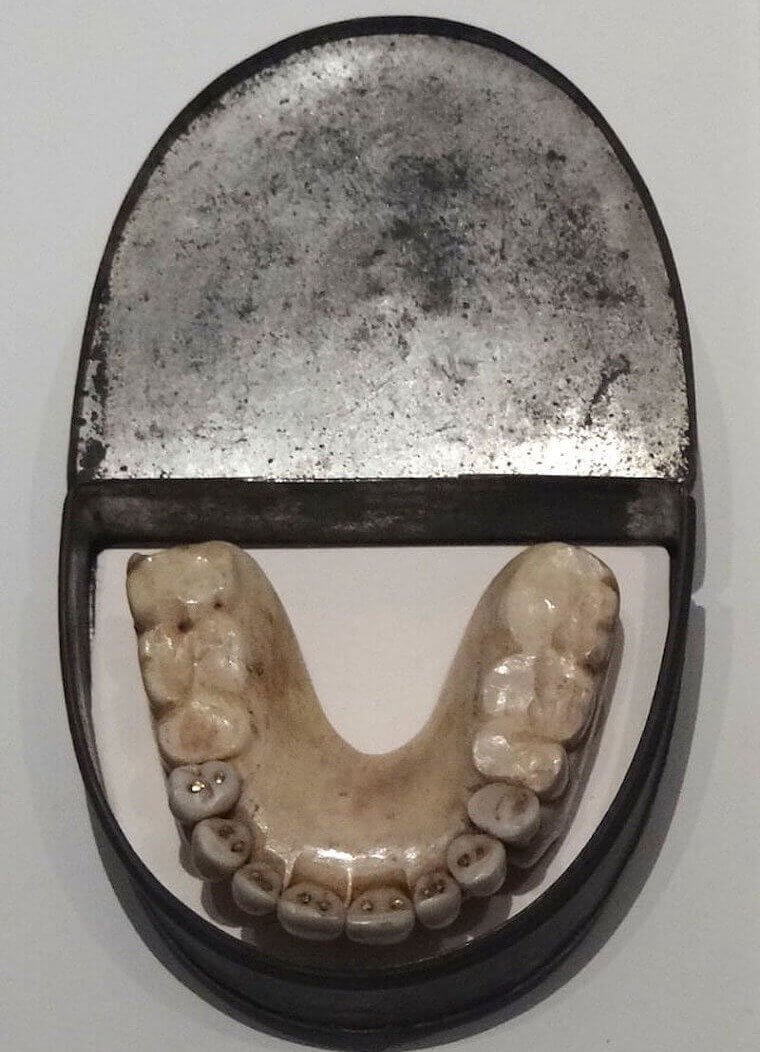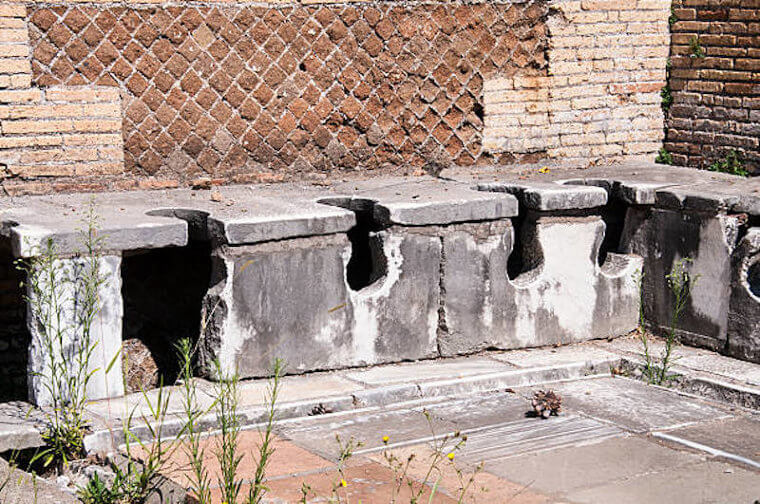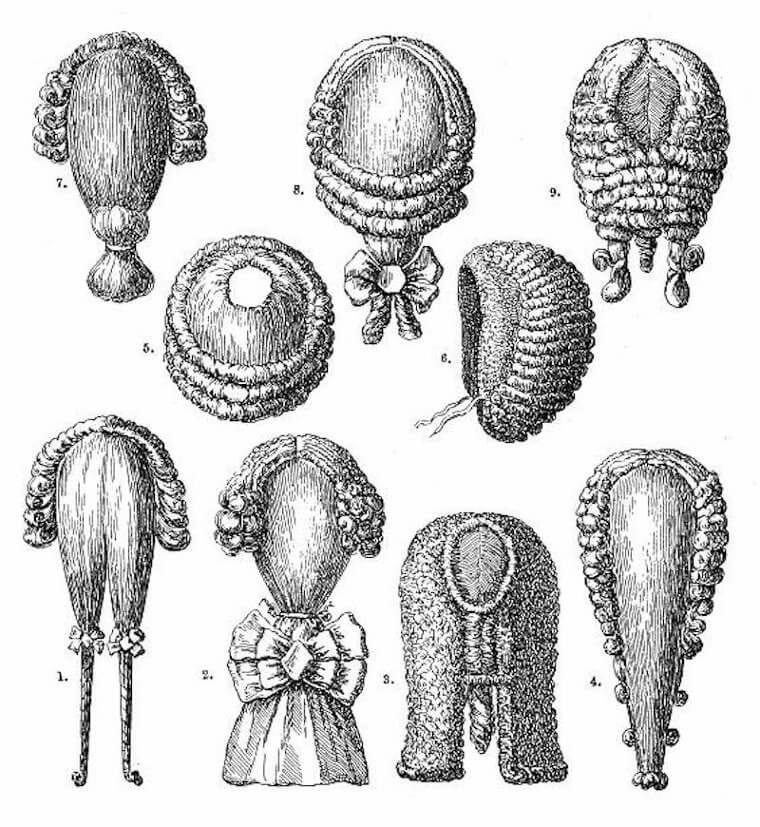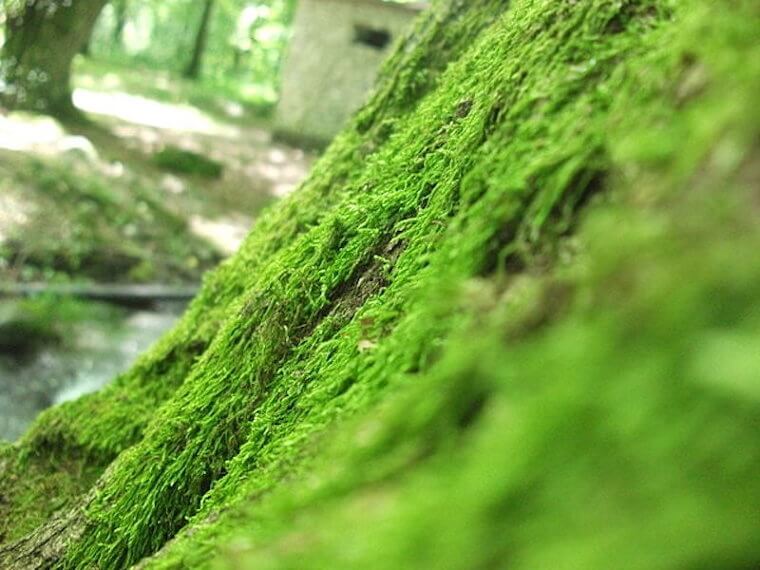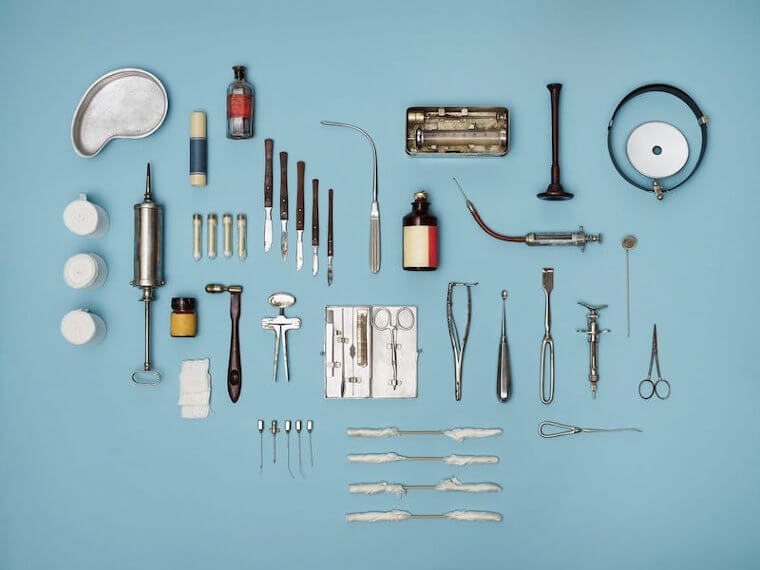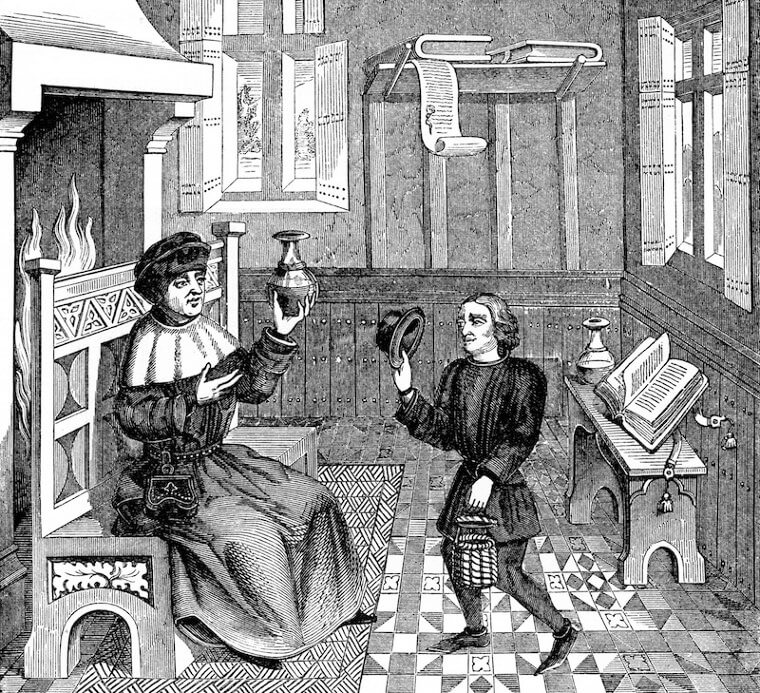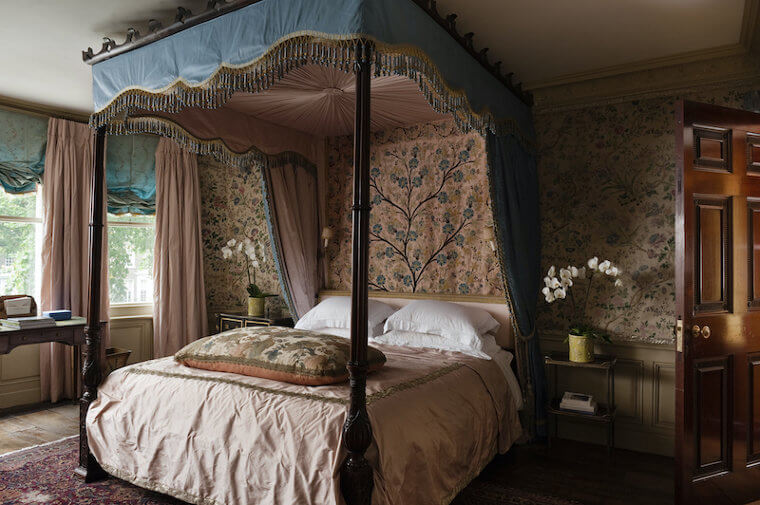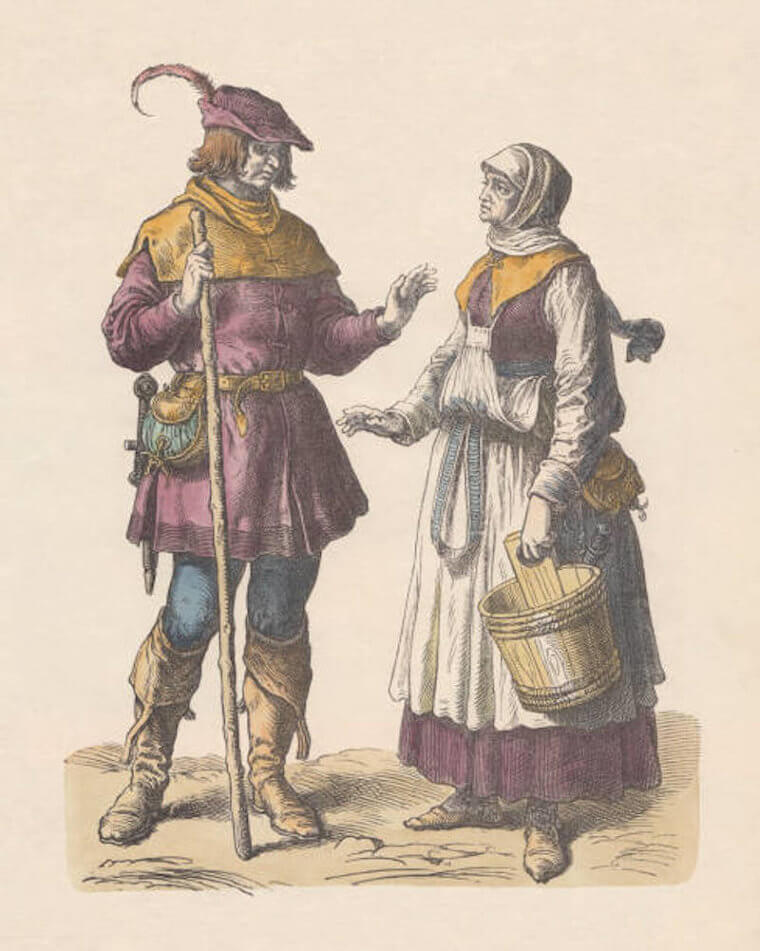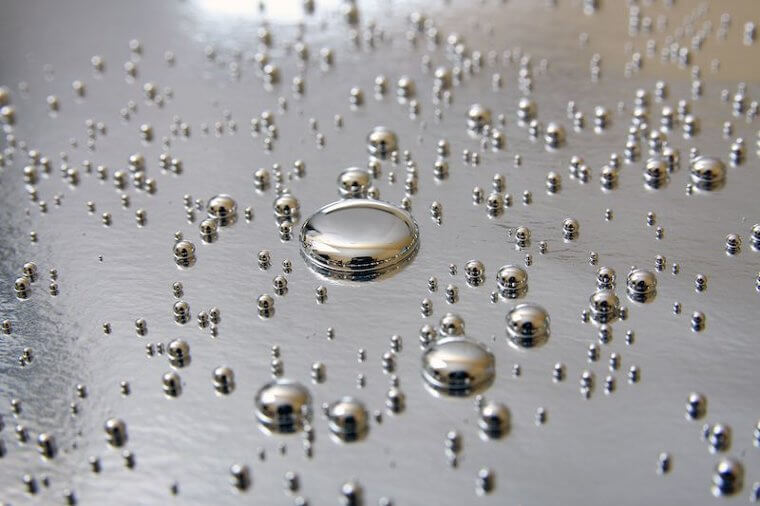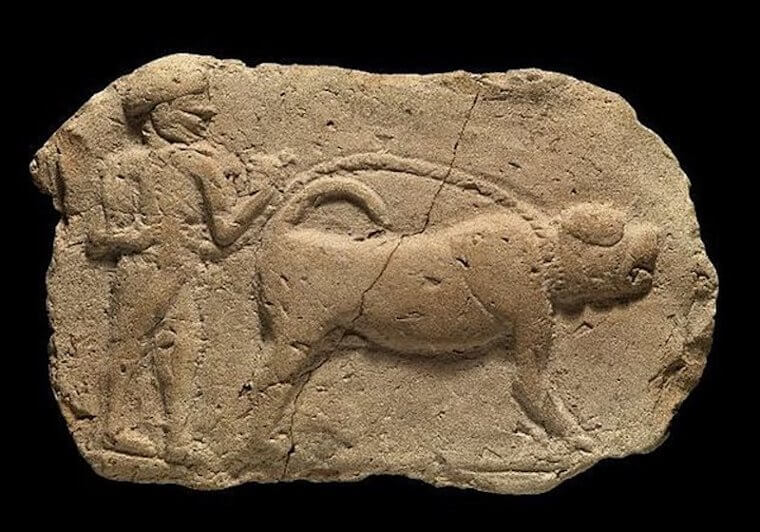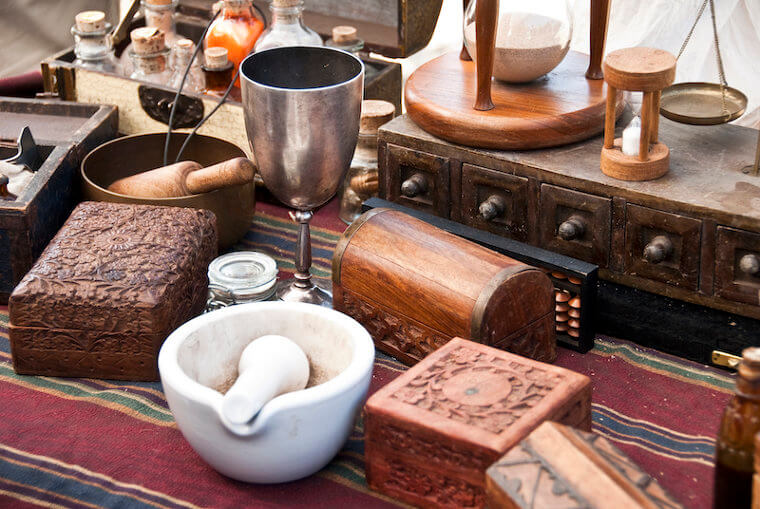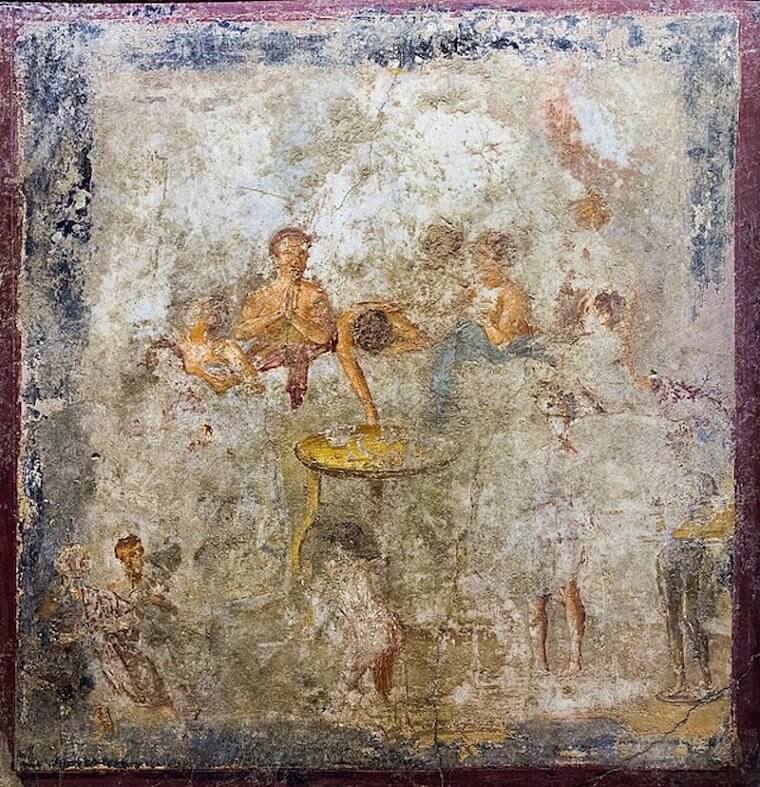Using Chamber Pots and Keeping Them Under the Bed
We all know the feeling of being comfortably tucked in a warm bed only to realize we drank too much water in the evening and we need to visit the bathroom one last time before falling asleep. Yes, leaving a warm bed is pretty annoying, but still, we wouldn't want to go back to the time when chamber pots were considered normal - and that happened up until the mid-20th century.
This type of portable toilet might have been the more convenient alternative to walking in the dark and in the cold to use the outhouse, but imagine the smell it must have left in the bedroom.
Trying to Treat the Black Death but Making Things Worse - Part 1
If dealing with the Covid-19 pandemic is difficult now, just imagine what it must have been like to live in the 14th century trying to control the Black Death. People had no clue what was going on, they didn't know what was causing it, how it was transmitted from one patient to another, what could be done to prevent it, and what was the best way to treat the infected. One of the beliefs was that a healthy person could catch the disease just by looking at the sick.
Unsurprisingly, then, doctors trying to treat their patients would recommend totally ineffective practices such as bathing in rosewater or vinegar, or burning aromatic herbs. But that wasn't even the worst part.
Turning Animal Dung into All Kinds of Treatments
Reading about these practices from the past gave us a new appreciation for modern medicine. Did you know that in ancient Rome, animal dung was believed to be useful in the treatment of all sorts of issues? According to Pliny the Elder, a Roman author, naturalist, and natural philosopher who wrote the encyclopedia Naturalis Historia (Natural History), she-goat's dung boiled down in vinegar, for instance, could be used on snake bites.
Tortoise dung, on the other hand, was the recommended treatment for a painful collection of pus, while rabbit dung supposedly kept dogs from barking at people?
Using Urine as an Antiseptic for Battle Wounds
Antiseptics are vital in medical situations as they slow down or completely stop the growth of microorganisms, reducing the risk of serious infections. That's great, but do you know what used to be considered a great antiseptic? Urine. In fact, Thomas Vicary, a leading surgeon in London in the mid-sixteenth century who was also Sergeant-Surgeon to King Henry VIII, recommended that all battle wounds should be washed in the yellow liquid.
The thing is that urine is not even sterile. The Tudor era sounds exciting and all, but we'll stick to our modern era with modern and widely available antiseptics that actually work.
Installing Private Toilets Right in the Kitchen
Ancient Roman public toilets were the stuff of nightmares with their lack of privacy, the methane buildup that created a serious risk of explosions, and the dangers of being bitten by insects on very tender parts. But having a private toilet at home wasn't much better, apparently. Back then, private toilets in residences were usually installed very near or right in the kitchen, and there was a practical explanation for that.
The toilets, which were just pits on the floor that weren't always connected to the sewers, were also used to dispose of food scraps, and just think about the smell of the average ancient Roman home.
Washing Your Hair with Egg Whites and Conditioning It with Bacon Fat
Nowadays, caring for your hair couldn't be easier - walk into any pharmacy, beauty store, or hairdresser, and you'll find dozens, if not hundreds of shampoos, conditioners, scalp remedies, and scrubs you didn't even know you needed. But in the "good old days"? Things weren't as easy. Egg whites were once commonly used as shampoo, and bacon fat was once a popular conditioner. We love eggs and bacon for breakfast, not as haircare!
Also, hearing about how women used to bleach their hair in the past made us grateful for our modern hair professionals. Back then, people trying to achieve light hair would use products like olive oil and onion skins.
Relieving Labor Pains with Eagle's Dung and Rosewater
Let's tell it like it is, childbirth is scary, and labor pains are a nightmare. But at least we have modern medicine now. Imagine what it must have been like to give birth in the Middle Ages, when eagle's dung mixed with rosewater was what they used to relieve labor pain. That's right - people applied a concoction of eagle's dung and rosewater on the woman's thighs and actually believed it was doing something.
Women would also wear all sorts and amulets and charms that were believed to speed up contractions as well, and we just want to take a moment to thank modern medicine and the modern epidural.
Accidentally Turning Toilets into Some Scary Version of Russian Roulette
If you paid attention to your History teacher back in high school, you might remember them telling you how advanced the ancient Roman sewer system was for the time - emphasis on the "for the time." The public facilities back then consisted of dozens of toilets open directly into the drainage channels without any type of U, S, Q, or J-shaped pipes. Why is that a problem? Because the buildup of methane basically meant those toilets could explode at any moment.
Another major issue? Insects could easily emerge from the openings on the floor and bite whoever was using the toilet. Jets of flame and biting insects (not to mention the complete lack of privacy)? Going to the bathroom in ancient Rome was like the scariest version of Russian roulette ever!
Trying to Treat the Black Death but Making Things Worse - Part 2
Doctors would sometimes prescribe treatments that made their patients even sicker, or spread the illness even faster. For instance, some believed that the best thing was to press the shaved bottom of a live chicken against the boils of an infected person - which would only infect the chickens and help spread the disease. Another crude technique involved, you guessed it, manipulating dung. Why people used to believe dung had healing properties, we'll never know.
Human excrement was applied to the boils, making the ill not only not recover, but also develop new problems. The worst, however, was when doctors burst the boils, which, again, only helped spread the disease.
Making Toothpaste Out of Oyster Shells and Mouse Brains
The first mass-produced toothbrush is believed to date from the 18th century, and the first fluoride toothpastes weren't introduced until the early 20th century. But humans have been taking care of their teeth at least since 3500-3000 BC, according to evidence - they just weren't amazing at it. The ancient Romans, for instance, did their brushing with the help of twigs, but it's their choice of "toothpaste" that really intrigues us.
Apparently, their dental hygiene included using items such as crushed up oyster shells, bones, charcoal, bark, and even mouse brains, for some reason. The crushed-up stuff was probably way too abrasive for their teeth, and the mouse brains? We don't even know what to say about that.
Living with Livestock and Being Plagued with Parasites
Vikings are often depicted as brave, robust, and feared, but recent findings reveal that being one of them probably wasn't that great. Vikings might have been fierce warriors, but they lived close to their livestock and had chronic stomach problems because their guts were heavily infested with parasites. They started having issues at a young age, and by the time they were adults, they would have chronic roundworm and liver fluke infections. Researchers also found evidence of whipworms, proving once and for all that being a Viking was not fun.
Their gas was awful-smelling, and they lived with severe diarrhea. Going number two was also likely a painful experience every time, so thank goodness we finished watching the show Vikings before we knew any of this stuff.
Making Dentures Out of Real Teeth
Modern dentures are made of many different materials including porcelain, composite resin, acrylic resin, and acrylic, and they are expertly crafted to look like real teeth and to perfectly fit their wearer's mouth. But in the past, dentistry was a lot creepier than it is now, even for those who are still afraid of going to the dentist. Have you ever heard of "Waterloo teeth"? It references the Battle of Waterloo where almost 50,000 soldiers died, so you know it can't be a good thing.
Waterloo teeth were dentures made with real human teeth, and they had this name because it was common practice for the teeth to be taken from battlefield casualties. Your modern dentist doesn't seem so scary now, right?
Drinking Wine That Was Bursting with Bacteria
For some reason, hearing the words "ancient Greece" immediately makes a lot of people think of toga-wearing ancient Greeks drinking delicious wine, but learning about how the beverage probably tasted like back then changed everything for us. Apparently, ancient wine wasn't tasty at all, unless it was like, super fresh. The problem is that people didn't know how to preserve the drink for long periods, but they tried their best. Are you scared? You should be scared.
People added salt, lead, and/or marble dust to their wine in an attempt to make it last longer. They would also leave it outside to oxidize until it was bursting with bacteria. We're not experts, but that doesn't sound delicious.
Using a Communal Sponge on a Stick to Clean Yourself in the Bathroom
If you look at the list of the ten most common fears people hold, you'll see stuff like "fear of spiders," "fear of heights," or "fear of thunder." After doing the research for this article, we may have discovered a new fear - the fear of having to use an ancient Roman bathroom. Do you know how the ancient Romans used to clean themselves after going number two? Hint - it was not with ancient Roman toilet paper.
They used something called a xylospongium, which was basically a sponge attached to the end of a stick. People did their business, used the xylospongium, then kindly put it back in its basin of water for the next person to use.
Shaving Your Head to Avoid Lice but Wearing Lice-Infested Wigs
People in the 17th century apparently attempted to combat lice by shaving their heads and wearing wigs instead, but the way we see it, they were just replacing one problem with another - the wigs, which were made of horse, goat, or human hair, would also attract lice, and they would start smelling after continuous use. They tried using cornstarch scented with orange and lavender to cover up the stink, but we all know there's only so much a dry shampoo can do.
The wigs eventually had to be sent back to the wigmaker for cleaning and delousing, meaning they boiled the hairpiece. The lice would eventually return though, which is why courtly ladies would carry long metal scratching sticks - to scratch their lice-infested hairdos. Ah, the glamour of French aristocracy!
Cleaning Yourself with the Same Oil Somebody Else Just Used
The fact that people nowadays are familiar with the term "Roman baths" leads us to believe that baths were a big deal to the ancient Romans, and therefore personal hygiene was very important to them. However, it turns out that their approach to personal hygiene was very different from ours, and it does not sound like something we'd be into. Here's how they used to clean themselves in the days before soap: with scented olive oils, and a strigil.
They would smear their bodies with the oils and then scrape it off using the metal instrument. That doesn't sound so weird, but the thing is that the dirty oil would be poured into a pitcher and reused by the next guest, or even repurposed as hair conditioner.
Believing That Cavities Are Caused by Tooth Worms
You may complain about going to the dentist now, but as unpleasant as that experience might be, at least modern dentists actually know what they're doing. In ancient Rome, people's knowledge of cavities, for instance, was quite laughable. They used to think that cavities were caused by worms nibbling the inside of the teeth, and since they didn't know about the correct cause, they also didn't know about the correct treatment.
In fact, one doctor who once claimed to have cured Emperor Claudius' toothache said he was able to expel the worms with a hot water rinse, and we know this is none of our business, but Emperor Claudius: that man was scamming you.
Contaminating Your Food Supply Every Time You Fertilize Your Crops
Agriculture was the key development in human civilization as we know it today, but it took a long time and a lot of trial and error until we understood what worked and what didn't work. The use of fertilizers sharply increased crop yields, but people didn't know how to do it properly, and in ancient Rome, fertilizing the crops also meant contaminating the entire food supply, simply because they didn't know any better.
Today, we are aware that excrements meant to be used as fertilizer in crops need to be composted for several months to ensure the elimination of parasitic eggs. The ancient Romes unfortunately skipped this step.
Accepting Trash as "Just a Fact of Life" and Throwing It Everywhere
Pompeii was once a thriving and sophisticated Roman city, and any history buff would have loved to visit it before the catastrophic eruption of Mount Vesuvius in 79 A.D. that buried it under 20 ft of volcanic ash and pumice - or would they? Apparently, Pompeii was absolutely overflowing with garbage, because trash was regarded as "just a fact of life," and therefore people would dump it wherever they felt like it.
Fossilized remains of rotting food show that streets, cemeteries, houses, and everything else was treated like one giant trash can. If they ever invent a time machine that could take us back to Pompeii, we definitely wouldn't want to be there in the summer months.
Looking at the Palace of Versailles and Seeing One Huge Bathroom
The Palace of Versailles is a major representative of French 17th century art, a symbol of luxury and opulence, a World Heritage Site. That's how we see it today, but apparently, in the past, the former royal residence was seen by some as one huge bathroom. As glamorous as it was, the Palace didn't have enough public water closets to accommodate Louis XIV’s huge court, so many people simply did their business in the corner.
And then there's this woman, Princesse d'Harcourt, who apparently didn't even bother going to a corner - it is said that she often did her number one casually as she walked. It is also said that she was strongly disliked by her servants. We wonder why.
Believing in the Medicinal Properties of Skull Moss
Hundreds of years ago people used to ingest remedies containing human bones, blood, and fat, and while it's a relief to know that this type of practice is in the past, if you think about it, a couple of hundred years is not that long ago... Shudder! Here we have a "remedy" that didn't actually involve a human body part, just something growing on it - more specifically, something growing on a dead man's skull.
When soldiers died on the battlefield, their bodies often remained unburied, and as they decomposed, a certain type of moss would start growing on their skulls. That moss was believed to cure anything from nosebleeds to epilepsy, and we would rather let our nose bleed.
Sharing Public Bathing Facilities with the Ill
In ancient Rome, doctors would often tell their patients to cleanse themselves in a bath as part of their treatment, which sounds nice and relaxing if you're thinking about a bath in your own bathtub in your own house, but that's not really what happened back then. Back then, the ill would take their bath in public bathing facilities, which caused a health issue - the infectious diseases could easily contaminate everyone else.
It wasn't until the rule of Hadrian, who was emperor from 117 to 138, that bathhouses started having special opening hours for the sick, who could come and cleanse themselves but stay separate from the healthy.
Making Feminine Hygiene Products Out of Napkins Wrapped Around Moss
Being a woman today is hard, but it still beats being a woman in ancient Greece, ancient Rome, or medieval Europe - at least today, modern feminine hygiene products are sold everywhere, are accessible and ready to use, and aren't made of moss. What? We'll get there in a minute. First let's start with ancient Greece, where women used to fashion tampons from pieces of wood wrapped in lint. Now let's move to Rome, where pads were made of wool.
It sounds like technology is evolving, doesn't it? But then we get to medieval women, who would wrap old cloths and rags around moss, which apparently is very absorbent?
Using Liquid Body Waste as Mouthwash
We were trying to find a way of saying this that would make the practice sound a little less gross, but there's no easy way to put it - Ancient Romans used animal and human liquid body waste as mouthwash. Yes, they rinsed their mouths with urine, which was seen as a bleaching agent that removed stains from the teeth. We don't know about you, but we would rather have yellow teeth than use this type of natural mouthwash.
Let's say it did work. We wonder who was the first person who thought that rinsing their mouth with this product would give them a nicer-looking smile.
Not Washing or Sterilizing Surgical Equipment
It's crazy to think about how quickly modern medicine advanced in such a short time. Can you imagine that only two hundred years ago, we didn't know that it was important for doctors to wash their hands before performing surgery? The same probe was used for the wounds of all patients during rounds, bed linen and laboratory coats weren't washed, and surgical equipment was rarely cleaned. No wonder death rates were so high!
If you had an injury that was prone to infections, doctors just went ahead and amputated that whole limb, which perhaps was even worse, because after all, they didn’t have any decent anesthetics.
Diarrhea Was Seen as a Good Sign
Imagine going to your doctor to complain about the severe diarrhea you've been experiencing ever since you started their recommended treatment for a tummy ache, and the reply you got from them was simply, "Good, it means it's working." That's what often happened in medieval medicine, when the general mindset was that, if the treatment is doing anything, it's probably working. Man, people back then just had no idea how anything worked.
A known side effect to their remedy for stomach worms was brutal diarrhea, which doctors assumed was good because they thought it meant the body was getting rid of the worms.
Sleeping Among Bugs and Bird Droppings
People today see four-poster beds with a canopy as a symbol of luxury, the type of furniture owned only by rich people or fancy hotels. But the alleged reason why beds with four poles and a canopy were invented in the first place is much less glamorous than we could have possibly imagined. Some say that canopy beds arose from a need for warmth and privacy in shared rooms without central heating.
However, there's also the theory that because houses didn't have the protective roofing they have today, it was common for bugs and bird droppings to fall right into people when they were sleeping, and canopies started being used to keep out those surprises.
Keeping "Clean" by Changing Clothes but Never Bathing
For a lot of people nowadays, personal hygiene means showering, washing their hair, changing their clothes, doing laundry, and washing their hands - and repeating those many times a day, once a day, or at least a few times a week, depending on the activity. But for people in the 1700s, our modern routine would have sounded excessive and unreasonable. Back then, people in the upper classes rarely bathed, and only occasionally washed their hands or faces.
Their idea of keeping themselves "clean" was more about changing the linens under their clothing - the important thing was to keep those clothes worn next to the skin clean, as if that would guarantee the cleanliness of the body.
A Horrifying Treatment for a Horrifying Illness
The first well-recorded European outbreak of syphilis occurred in 1495, during the French siege on Naples, and unsurprisingly, people back then had no idea what it was, how it was transmitted, and how to properly treat it. The point is that from there, it spread across Europe, and it is estimated that more than 20% of individuals between the ages of 15 and 34 years old in late 18th century London were treated for the illness.
And how were they treated? A popular method involved the use of mercury, which we all know is extremely toxic. Sometimes, the substance was administered orally, and sometimes, er, the substance visited a town a little south from there.
Using Toilet Paper That Was Full of Splinters
The Great Toilet Paper Shortage of 2020 made us realize just how modern society loves their TP, and after hearing about what this item used to be like a century ago, it's no wonder we feel so protective of our quilted, extra comfort, triple-ply toilet paper. In 1935, a company advertising their TP actually used the tagline "Splinter-Free!" to sell their product, which means that splinter-y toilet paper was a normal thing at the time?
We have so much to worry about nowadays, and sometimes we wish we had been born decades ago, in simpler times. But wow, we do not want to live in an era when we would have to worry about the dangers of splinter-y toilet paper.
Using Feral Dogs and Scavenging Pigs as Garbage Control
It's estimated that the first examples of organized solid waste management systems didn't appear in Europe until the late 18th century, so we can only imagine how people used to live before that. Spoiler alert - in filth; they used to live in filth. In ancient Mesopotamia, their only "garbage control" was apparently feral dogs and scavenging pigs that were allowed everywhere, and we mean everywhere, including inside the palace of the king.
Unsurprisingly, garbage covered every inch of the cities, attracting rats, fleas, and other carriers of diseases. If you are wondering if the Mesopotamians ever dealt with plague epidemics, the answer is yes.
Prescribing "Medical" Products Made Out of Human Blood and Flesh
We were today years old when we learned that in 16th and 17th century Europe, doctors regularly prescribed remedies made with human bones, flesh, and blood to treat anything from headaches to epilepsy. There was even a name for this type of practice - "corpse medicine." A popular "ingredient" was Egyptian mummy, and we have to wonder how they even got their hands on those, but powdered mummy skulls, for instance, were believed to cure head ailments.
King Charles II had his own personal concoction that he consumed regularly - it was called King's Drops, and its "active ingredient" was crushed human skulls.
Turning Liquid Body Waste into Laundry "Soap"
Who doesn't love the smell of freshly washed clothes? Probably the ancient Romans, because their laundry "soap" was gross. Can you guess what it was? It was liquid body waste. Here's how it worked. Vessels for collecting liquid body waste were spread all over Rome, and anyone could use them to, ahem, "make a donation." When the vessels were full, they would be taken to a fullonica, which was like their laundromat.
The liquid waste would be diluted in water and poured over a bunch of dirty clothes, and then a laundry worker would stomp on them until they "clean." Hopefully they would also rinse it thoroughly with water, though we're not sure they did.
Living in Filth and Stench
Remember that Friends episode when Ross is describing the apartment of the woman he's going out with, and he says it's like throwing a jacket on a chair at the end of the day, but instead of a chair it's a pile of garbage, and instead of a jacket it's a pile of garbage? This is how we think of medieval Europe now. London, apparently, was filthy and smelly from rotting food, animal entrails, and all types of excrements overflowing the streets.
By the 14th century, the smell was reportedly so bad that the king banned the slaughtering of animals inside the city. That probably helped, because butchers used to throw rotting meat into the Thames, and blood and remains were just abandoned under the sun.
Employing a Personal Wiper
If you think your job is bad, think again. For centuries, there was a position in the king of England's court called "Groom of the Stool," or "Groom of the King's Close Stool," and this person was responsible for attending the king's toileting needs. What does that mean, exactly? Some say it means the king had a personal wiper, but some say his duties didn't extend to that extreme.
What we do know for sure is that this person was responsible for supplying water, towels, and a washbowl for the king after every royal number two; and he was also to monitor the king's diet and bowel movements. Your job doesn't seem so bad now, does it?
Drinking Horrifying Protein Smoothies
The 17th century was truly an era of experimentation, and it must have been fun to be a physician at the time, coming up with all types of crazy recipes for treating illnesses - it seems like people would believe anything you'd come up with. Take this recipe from English physician John French, for instance. French, who's known for publishing the handbook The Art of Distillation in 1651, came up with an "infallible medicine against the falling sickness."
His recipe started with the brains of a young man who has died a violent death, among some other ingredients, which should then be mashed, poured into a large glass, hermetically closed, and left in horse dung for half a year. Cheers!
Using Crocodile Dung as a Contraceptive
We never wrote the word "dung" so many times in a single list and we wonder how many times it appears on this page, but honestly, we're afraid of finding out, so we're just gonna move on. Here's another dung-related gross and unsanitary fact from the past for you, and this one involves our favorite large semi-aquatic reptiles - crocodiles! Back in ancient Egypt, women used crocodile dung as a contraceptive.
But they didn't use it alone, no, because that would be weird. They mixed it with sour milk until it formed a paste, and then they inserted it in their private areas.
Rarely Changing or Washing Your Clothes
Do you ever open your closet in the morning, look at all your clothes, and think to yourself, "I don't have anything to wear!"? Medieval peasants are judging you, because they actually knew what it was like to not have anything to wear - for real. Back then, regular people often only owned one set of clothing, and they dressed in layers to avoid having to wash their outer garments too often.
Those who could afford two sets of clothing would change into a fresh set every week while the other one was being washed. Laundry was done in the river, which is unfortunate, because the cities had no sewage treatment and waste was dumped directly in the water.
Throwing Unhygienic Dinner Parties
In ancient Rome, elite dinner parties were a display of status, and they were also an important opportunity for networking. Hosts always brought their A-game to impress their guests, and that usually meant serving the most expensive and exotics foods money could buy - in a single dinner, they could serve ostrich, flamingo, crane, turtle, partridge, goose, duck, chicken, porpoise, sole, mackerel, hake, bream, oysters, wild goat, benison, boar, suckling pig, veal, and hare.
Sounds impressive, however, the way they would eat all that food doesn't sound very appealing. They ate while reclining on sofas, and simply threw all the animal bones, skins, seafood shells, and olive pits on the floor.
Anything Related to the Production and Usage of a "Mellified Man"
We hope this is only a story invented by people with a wild imagination, but Chinese medical sources from the 16th century tell of a substance called a "mellified man." The production started with a person who would stop eating any food other than honey until even their sweat would be replaced by the substance. Once they died, the body would be placed in a stone coffin filled with honey and left to rest for a hundred years.
After all that time, the contents were transformed into a confection said to be capable of healing anything from ailments to broken limbs, and naturally, it was sold for a lot of money.

